Hagsploitation at the Séance - The Medium by Gian Carlo Menotti
Horror Moments, Opera Edition
‘Horror Moments’ is a weekly series examining horror-inflected scenes and themes in unexpected places. The ‘moments’ are published weekly on Thursdays, and I share articles on the history of magic, theatre, storytelling, and more on Mondays. Catch up with the recent Kate Bush series here and the full back catalogue of horror moments (from Wallace & Gromit to Shakespeare) here. Don’t forget to subscribe!
What’s scarier, voices from beyond the grave or an aging woman embittered by jealousy and regret? This week, we plunge into the realm of ‘hagsploitation’ to cast light on a strange little opera which puts this question to the test.
When Coralie Fargeat’s The Susbtance premiered in 2024 it was hailed as one of the best horror films of recent years. It’s a stylish ‘body horror’ fable about Elizabeth Sparkle (Demi Moore), an ageing celebrity who acquires a dodgy drug on the black market that promises youth and beauty. All she has to do is follow the instructions…
An editorial in The Guardian caused ripples of controversy when it claimed that The Substance – along with a spate of other female-led horror films – was in fact no less sexist than the films made by male directors, particularly when it came to depictions of older women:
“Ridiculed, beaten and bloodied, the figure of the hag refuses to disappear. Despite some bold attempts by women at reclaiming the horror genre, its misogynistic conventions are sadly proving durable too.”
The Substance, it claimed, was yet another ‘hagsploitation’ movie.
The Hags of Cinema
Tropes of the ‘hagsploitation’ or ‘psycho-biddy’ sub-genre, where older women are frightening because of their age, are found throughout the history of film. In The Old Dark House (1932), the comically menacing Rebecca Femm warns the young heroine that her flesh will one day rot, placing a withered hand on the young white neck.
Onibaba (1964) gave us a Japanese version of the trope, where a resentful older woman is tempted by the power of a strange demonic mask. The title of the film 鬼婆 literally means ‘demon hag’ although Nobuko Otowa, who played the unnamed ‘Older Woman,’ was only forty.
Recent films like Barbarian (2022) and The Front Room (2024) perhaps deserve the criticism they received for repeating the same clichés. It seems slightly unfair to group The Substance with these since it places a woman’s own view of her aging body at the centre of the drama. ‘Hagsploitation,’ strictly speaking, isn’t about the female fear of aging, it’s about fear of the aging female. You’ll have to watch them all to decide what you think.
Lie Down With Me, Young Man
The spectre of the frightening older woman is found, of course, in many a folktale, not just in the archetypes of witchcraft but in the medieval figure of the ‘loathly lady’ who demands sex from the hero. In “The Wife of Bath’s Tale,” one of the most compellingly unsettling stories in the Middle English canon, a rapist is forced to marry a hideous crone who has spared him from execution by helping him solve the riddle ‘what do women want most?’
In the folksong ‘King Henry,’ a demonic hag turns up at the king’s hall and demands vast quantities of food and wine before insisting that Henry go to bed with her:
Take off your clothes now King Henry
And lie down by my side,
Now swear, now swear you King Henry,
To take me for your bride.
Oh God forbid, says King Henry,
That ever the like betide,
That ever a fiend that comes from hell
Should stretch down by my side.
The Medium
When I first watched The Medium, a one-hour opera in two acts by Gian Carlo Menotti which was first performed in 1946, I was expecting to see a story about the spookiness of séances themselves where ghostly voices would sing from the other side. The horror was, instead, centred on the eponymous medium, Madame Flora. The opera is a character study of an unstable woman who bullies her daughter and cons her patrons.
In Act 1, we meet a young woman called Monica and her mute lover Toby who are dressing up together and messing around until Madame Flora, Monica’s mother, arrives. She is drunk and unpleasant, pestering them to get ready for the night’s performance. Flora knows full well that she has no real power, she enlists Monica to play the offstage voices of the ghosts and we watch her exploit the grieving relatives of a two-year old who never learned to speak and so communicates by laughing.
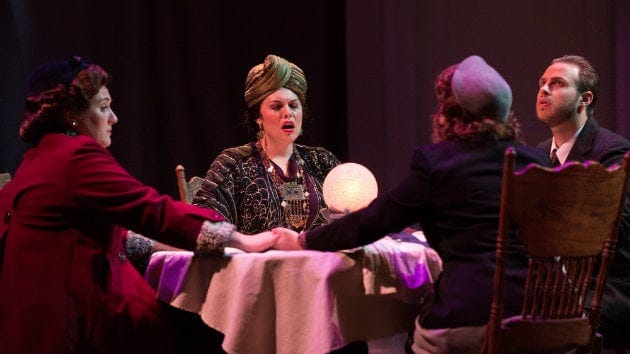
Yet suddenly, in the midst of it all, Madame Flora says she has actually felt phantom fingers clutching around her throat. She panics and the séance is ruined. She blames everyone around her as she starts to hear voices that no one else hears and the act ends with her reciting the Hail Mary over and over in abject terror.
By Act 2, Flora has grown even more unstable and is driving people away by telling them openly that she’s a fake. She’s drinking more and more and in the night, as Toby is rummaging around in the dark, she thinks he’s a ghost. ‘Speak or I’ll shoot!’ She cries, which is a stupid thing to do if you live with someone who can’t talk. He can’t reply so she shoots him.
And that’s basically the end.

The Medium is certainly a piece of hagsploitaton since Flora herself is the truly dangerous and disturbing element of the plot. There is an ‘old lady is jealous that a man loves her daughter’ subtext to her hatred of Toby that is found in films like Onibaba, and there’s something distinctly witchy about her ambiguous relationship with the supernatural.
On the other hand, the psychological landscape of the piece is the guilt-ridden mind of Flora herself. We see glimpses of the hardship that has driven her to her current profession and the self-hatred that fuels her cruelty towards others: “forgive my sins, I’m sick and old” she sings.
Our final vision of Flora is chilling. There’s real insanity in her leering triumph, her ludicrous cry of ‘I killed the ghost!’ The trappings of Victorian occultism are still nowhere near as scary as this unhappy woman with the gun.

Opera has, of course, been an enthusiastic participant in the hagsploitation genre for a long time and older female singers often end up playing mad bad and scary old women. There’s also a whole separate essay to be written about the demonisation of the Romany woman which goes hand in hand with hagsploitation and is hinted at in The Medium. Horror films have sometimes taken their cue here from tropes kept alive in opera, compare for example the vengeful Azucena in Verdi’s Il Trovatore and Mrs Ganush in Drag Me to Hell (2009):
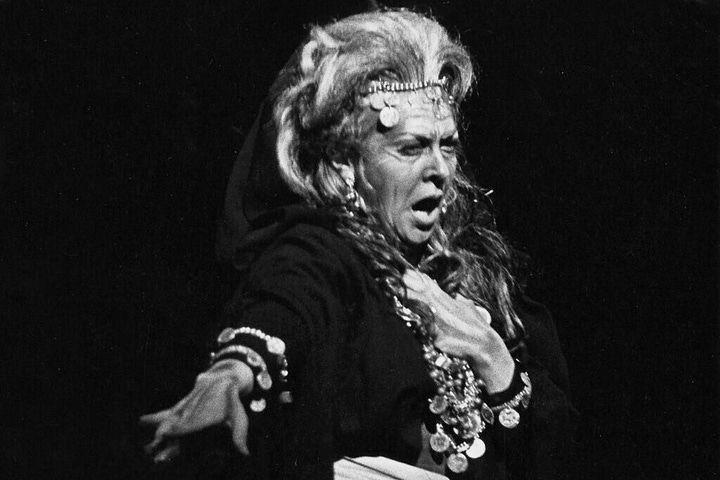
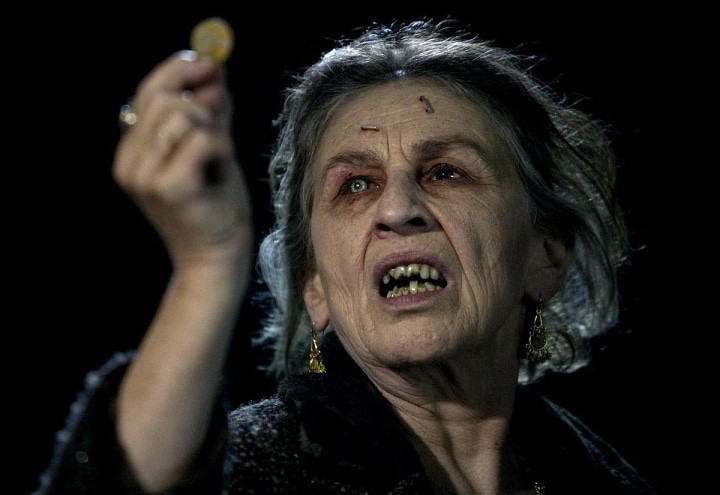
Quite why we feel this need to make monsters of old women, and why this is so often a feature of particular forms of racism, is a mystery to me. I can't help but feel optimistic that films like The Substance are moving us in the right direction. Then again, even in older works of art like The Medium, the humanity of the 'hag' is present. Whether because we pity her sorrow or accept that deep down she has good reason to be vengeful, there is something about her plight that compels us and disturbs us just as much as any ghoul or ghost.
Having said that, ghosts have often stalked the opera house, and next week we confront one of the most famous spectres in the history of music. Until then, happy nightmares everyone!
Horror moments are posted every Thursday and a wide variety of articles exploring the history of magic, theatre, storytelling, and more are published on Mondays.
Remember that you can pay to subscribe for extra benefits or buy me a coffee here to keep me writing. You can also like, share, comment, and recommend to help the substack grow. Thank you!

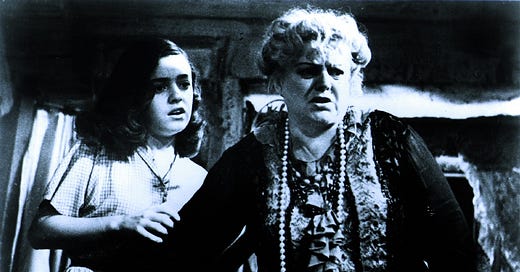



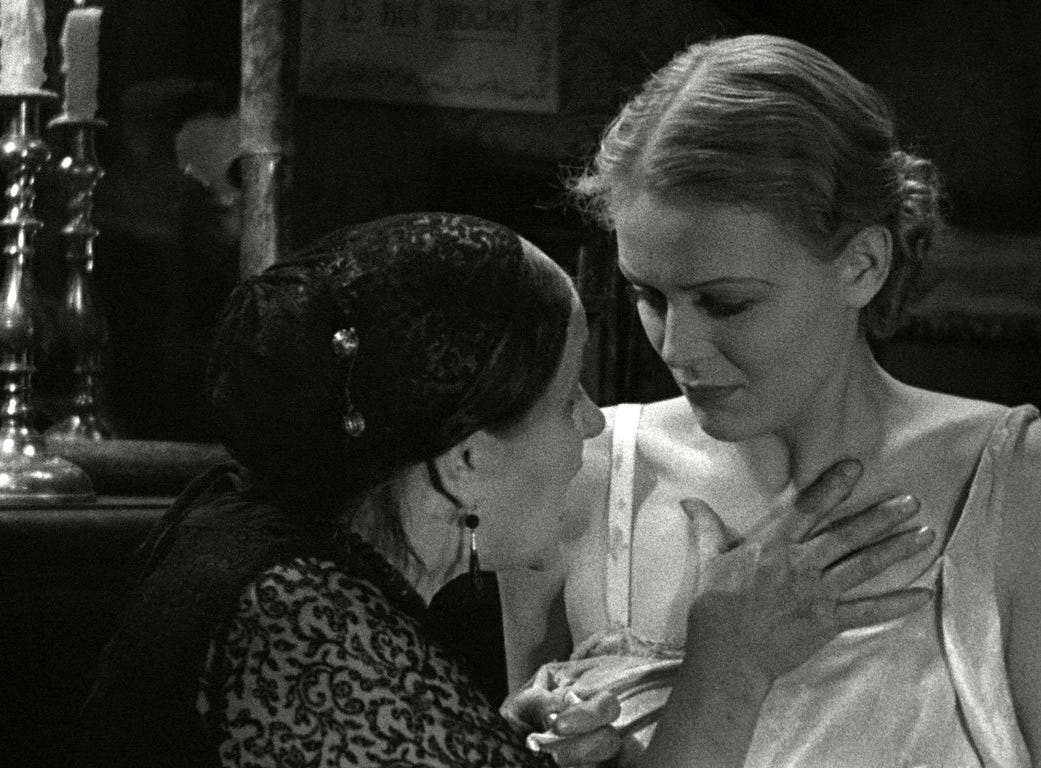

In another corner of substack someone was complaining women had to settle for frogs and beasts, and men all got princesses and I thought, all the hags out there turning into maidens….sister, you just aren’t paying attention!
But I don’t like starting fights so I let it go.
I feel we must have an honourable mention for Minnie Castevet in Rosemary's Baby -- a very glam and gloriously assertive "hag" as played by the brilliant Ruth Gordon.